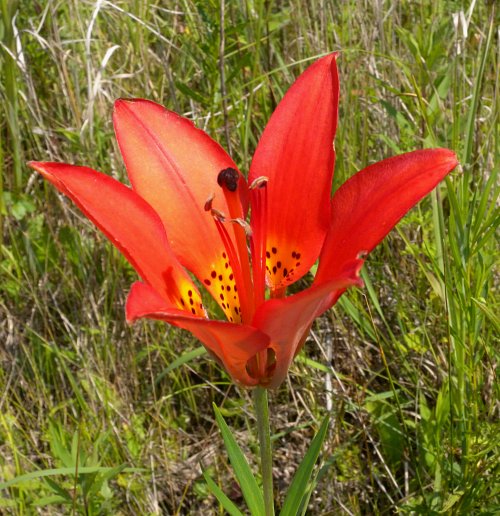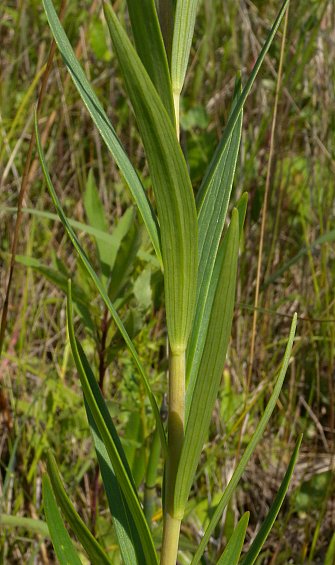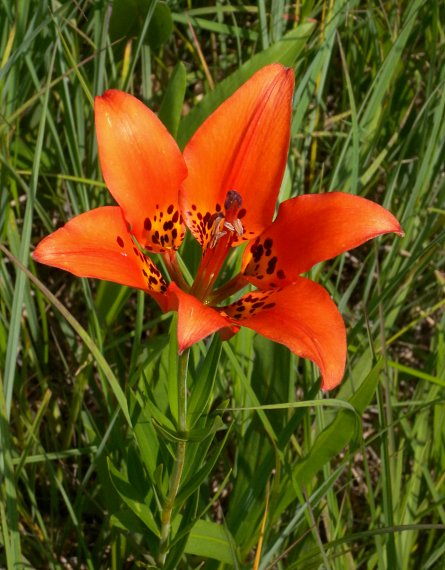
Each flower consists of 6 orange to reddish tepals, 6 stamens with orange to reddish filaments, an orange to reddish style with a swollen stigma, and a green ovary. The ascending tepals are narrowly clawed below and lanceolate to ovate above; they are slightly incurved below and slightly recurved above. A little above their clawed bases, the tepals are more yellowish and they have conspicuous purplish brown dots. Both stamens and style are slightly exserted; the stamens surround the style in the center of the flower. The blooming period occurs from early to mid-summer, lasting about 3-5 weeks. Afterwards, fertile flowers are replaced by oblongoid seed capsules that are 1½–2¾" long. Each seed capsule has 3 cells, and each cell has 2 columns of flattened seeds. The root system consists of a scaly corm that occasionally forms clonal offsets; the bottom of the corm develops shallow fibrous roots.
Cultivation: The preference is full or partial sun, moist to mesic conditions, and soil containing loam or sandy loam. This plant develops slowly.

Range & Habitat: The native Prairie Lily is uncommon in northern Illinois, while in the rest of the state it is rare or absent (see Distribution Map). Populations of this plant have been declining, or they have been extirpated, in some areas. Habitats include thinly wooded bluffs, moist to mesic black soil prairies, moist to mesic sand prairies, grassy meadows, and powerline clearances through natural areas. Prairie Lily is normally found in high quality natural areas. Occasional disturbance that involves removal of woody vegetation is probably beneficial in maintaining populations of this plant. Because of the showy flowers, it is vulnerable to poaching, like many orchids.
Faunal Associations: The flowers are cross-pollinated primarily by large butterflies, including swallowtail butterflies (Papilionidae), the Monarch butterfly (Danaus plexippus), and Great Spangled Fritillary (Speyeria cybele). Other floral visitors include the Ruby-throated Hummingbird, hummingbird moths (Hemaris spp.), and Halictid bees. Most of these floral visitors suck nectar from the flowers, although the Halictid bees collect pollen (see Graenicher, 1907; Edwards & Jordan, 1992). Other insects feed destructively on Prairie Lily (Lilium philadelphicum andinum) and other closely related lilies (Lilium spp.). These insects include the introduced Lily Leaf Beetle (Lilioceris lilii), Crescent-marked Lily Aphid (Aulacorthum circumflexum), Purple-spotted Lily Aphid (Macrosiphum lilii), and larvae of the Golden Borer Moth (Papaipema cerina), Burdock Borer Moth (Papaipema cataphracta), and Stalk Borer Moth (Papaipema nebris); see Clark et al. (2004), Cranshaw (2006), Pepper (1965), Panzer et al. (2006), and Natural History Museum (2010). The larvae of these latter moths bore through the stems and corms of lilies. Mammalian herbivores readily consume the foliage of Prairie Lily and other closely related lilies, especially the White-tailed Deer. The corms are also eaten sometimes by voles.

Photographic Location: A powerline clearance and moist sandy meadows at a state park in NE Illinois.
Comments: The flowers of this plant can be remarkably large, considering its size. This is arguably one of the most beautiful wildflowers in Illinois. Other native lilies (Lilium spp.) in Illinois are taller plants with whorled leaves and drooping flowers; only the flowers of Prairie Lily (Lilium philadelphicum andinum) remain erect. One reason why this plant has erect flowers is that the anthers can close their pores temporarily in response to rain, thereby protecting the pollen (Edwards & Jordan, 1992). This is a highly unusual characteristic. The typical variety of this plant is the more eastern Wood Lily (Lilium philadelphicum philadelphicum), which is not found in Illinois. The Wood Lily differs from the Prairie Lily in being a slightly taller plant that has mostly whorled leaves, its leaves are usually wider (often exceeding ½" across), and its seed capsules are slightly shorter. In the past, the Prairie Lily was sometimes classified as a distinct species, or Lilium umbellatum. Other common names for this plant are Western Lily and Wood Lily. Outside of Illinois, there are yellow-flowered forms of this species.